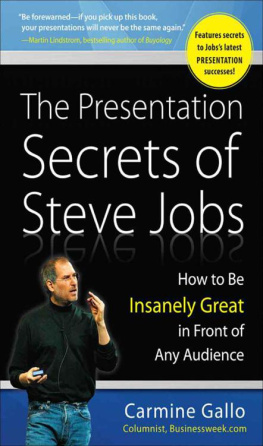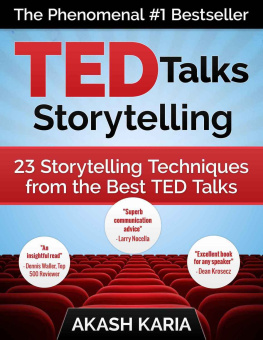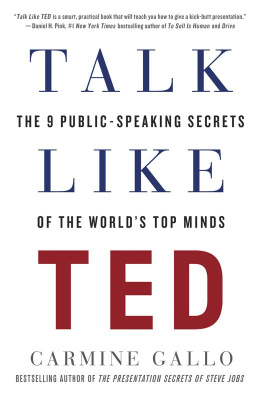
The author and publisher have provided this e-book to you for your personal use only. You may not make this e-book publicly available in any way. Copyright infringement is against the law. If you believe the copy of this e-book you are reading infringes on the authors copyright, please notify the publisher at: us.macmillanusa.com/piracy.
*Please note that some of the links referenced in this work are no longer active.
To Vanessa, with love and gratitude
CONTENTS
INTRODUCTION
Ideas Are the Currency of the Twenty-first Century
Im a learning machine and this is the place to learn.
TONY ROBBINS, TED 2006
IDEAS ARE THE CURRENCY OF the twenty-first century. Some people are exceptionally good at presenting their ideas. Their skill elevates their stature and influence in todays society. Theres nothing more inspiring than a bold idea delivered by a great speaker. Ideas, effectively packaged and delivered, can change the world. So, wouldnt it be amazing to identify the exact techniques shared by the worlds greatest communicators, watch them deliver jaw-dropping presentations, and apply their secrets to wow your audiences? Now you can, thanks to a world famous conference that posts its best presentations for free on the InternetTED (Technology, Entertainment, Design), a scientific analysis of hundreds of TED presentations, direct interviews with TEDs most popular speakers, and my personal insights gleaned from years of coaching inspiring leaders of the worlds most admired brands.
Talk Like TED is for anyone who wants to speak with more confidence and authority. Its for anyone who delivers presentations, sells products and services, or leads people who need to be inspired. If you have ideas worth sharing, the techniques in this book will help you craft and deliver those ideas far more persuasively than youve ever imagined.
In March 2012, civil rights attorney Bryan Stevenson delivered a talk to 1,000 people attending the annual TED conference in Long Beach, California. He received the longest standing ovation in TED history, and his presentation has been viewed nearly two million times online. For 18 minutes Stevenson held the audience spellbound by appealing to their heads and their hearts. The combination worked. Stevenson told me that the attendees that day donated a combined $1 million to his nonprofit, the Equal Justice Initiative. Thats over $55,000 for each minute he spoke.
Stevenson did not deliver a PowerPoint presentation. He offered no visuals, no slides, no props. The power of his narrative carried the day. Some popular TED speakers prefer to use PowerPoint to reinforce the impact of their narrative. In March 2011, professor David Christian launched a movement to teach Big History in schools after delivering a riveting 18-minute TED talk backed by visually engaging slides and intriguing graphics. Big history teaches students how the world evolved and its place in the universe. Christians presentation, which covers 13 billion years of history in 18 minutes, has been viewed more than one million times.
Christian and Stevenson have seemingly different presentation styles and you will hear from both of them in this book. One tells stories, the other delivers mountains of data with image-rich slides, yet both are captivating, entertaining, and inspiring because they share nine secrets. They understand the science and the art of persuasion.
After analyzing more than 500 TED presentations (more than 150 hours) and speaking directly to successful TED speakers, Ive discovered that the most popular TED presentations share nine common elements. Ive also interviewed some of the worlds leading neuroscientists, psychologists, and communications experts to gain a better understanding of why the principles that underlie these elements work as well as they do. Best of all, once you learn the secrets these communicators share, you can adopt them and stand out in your very next pitch or presentation. These are techniques Ive used for years to coach CEOs, entrepreneurs, and leaders who have invented products or run companies that touch your life every day. While you may never speak at an actual TED conference, if you want to succeed in business youd better be able to deliver a TED-worthy presentation. It represents a bold, fresh, contemporary, and compelling style that will help you win over your audience.
IDEAS WORTH SPREADING
Richard Saul Wurman created the TED conference in 1984 as a onetime event. Six years later it was reinvented as a four-day conference in Monterey, California. For $475, attendees could watch a variety of lectures on topics covering technology, entertainment, and design (TED). Technology-magazine publisher Chris Anderson purchased the conference in 2001 and relocated it to Long Beach, California in 2009. In 2014, the TED conference begins a run in Vancouver, Canada, reflecting its growing international appeal.
Until 2005 TED was a once-a-year event: four days, 50 speakers, 18-minute presentations. In that year, Anderson added a sister conference called TEDGlobal to reach an international audience. In 2009, the organization began granting licenses to third parties who could organize their own community-level TEDx events. Within three years more than 16,000 talks had been delivered at TEDx events around the world. Today there are five TEDx events organized every day in more than 130 countries.
Despite the astonishing growth in the conference business, TED speakers were introduced to a much larger global audience through the launch of TED.com in June 2006. The site posted six talks to test the market. Six months later the site only had about 40 presentations, yet had attracted more than three million views. The world was and still is clearly hungry for great ideas presented in an engaging way.
On November 13, 2012
The first six TED talks posted online are considered classics among fans who affectionately call themselves TEDsters. The speakers included Al Gore, Sir Ken Robinson, and Tony Robbins. Some of these speakers used traditional presentation slides; others did not. But they all delivered talks that were emotional, novel, and memorable. Today TED has become such an influential platform, famous actors and musicians make a beeline to a TED stage when they have ideas to share. A few days after accepting the Oscar for best picture, Argo director Ben Affleck appeared at TED in Long Beach to talk about his work in the Congo. Earlier in the week U2 singer Bono delivered a presentation on the success of antipoverty campaigns around the world. When celebrities want to be taken seriously, they hit the TED stage. Facebook COO Sheryl Sandberg wrote her bestseller Lean In after her TED presentation on the subject of women in the workplace went viral on Theres no event like it, Zuniga says. Its four days of learning, passion, and inspiration stimulating intellectually, but I never thought the ideas I heard would move my heart as well. Oprah Winfrey once put it even more succinctly: TED is where brilliant people go to hear other brilliant people share their ideas.
THE PRESENTATION SECRETS OF STEVE JOBS
Im in a unique position to analyze TED presentations. I wrote a book titled The Presentation Secrets of Steve Jobs , which went on to become an international bestseller. Famous CEOs are known to have adopted the principles revealed in the book, and hundreds of thousands of professionals around the world are using the method to transform their presentations. I was flattered by the attention, but I wanted to reassure readers that the techniques I explored in Presentation Secrets were not exclusive to Steve Jobs. The Apple cofounder and technology visionary just happened to be very good at putting them all together. The techniques were very TED-like.







